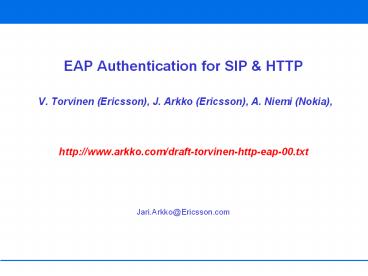EAP Authentication for SIP - PowerPoint PPT Presentation
Title:
EAP Authentication for SIP
Description:
... mobile networks will provide a multimedia system that runs over IP and uses SIP ... on security to ensure such multimedia service can be trusted and can ... – PowerPoint PPT presentation
Number of Views:30
Avg rating:3.0/5.0
Title: EAP Authentication for SIP
1
EAP Authentication for SIP HTTP V. Torvinen
(Ericsson), J. Arkko (Ericsson), A. Niemi
(Nokia),http//www.arkko.com/draft-torvinen-ht
tp-eap-00.txt
- Jari.Arkko_at_Ericsson.com
2
Current SIP Authentication Situation
Existing security can be used at an outer layer
HTTP basic HTTP digest PGP
Work has started to extend DIAMETER to support
HTTP authentication methods
Certain SIP-specific methods exist. Work going on
to refine these.
3
How Does This Work Fit to the Picture?
HTTP basic HTTP digest HTTP EAP PGP
- We define a new alternative HTTP
- authentication method which is
- more flexible than previous ones
- takes less roundtrips than e.g. IKE
- implies no changes protocols or SIP server as
new auth mechanisms are invented
We reuse existing AAA protocols directly
4
Background for Our Work
- Third generation mobile networks will provide a
multimedia system that runs over IP and uses SIP - The 3GPP is working on security to ensure such
multimedia service can be trusted and can be
billed for - One of the issues is the authentication of
devices/users towards the home operator during
registration - Wed like to define a mechanism that satisfies
the requirements of 3GPP networks as well as
other uses of SIP - 3GPP needs UMTS AKA and other authentication
methods - EAP (RFC 2284) for allow many methods
5
3GPP Requirements
- Use less roundtrips per authentication event
- Use SIP authentication rather than an outer
layer protocol such as TLS or IKE. - Find light but secure authentication method
- Do not apply HTTP basic/digest or PGP because
they are either insecure or too heavy. - Do not develop a new method
- Authentication is typically applied at
registration time - 3GPP needs to use UMTS AKA for authentication
- Devices already have a SIM card for this purpose
- For access independence and ability to use
laptops without SIM cards, other methods also
highly desirable - A generic scheme such as GSS_API, SASL, EAP is
therefore desired
6
Introduction to EAP
- Extensible Authentication Protocol, RFC 2284
- Originally used in PPP
- Being adopted for WLANs, possibly for Bluetooth
- Extensible protocol framework
- Same protocol can carry various authentication
methods - AAA protocols for carrying EAP exist (RADIUS and
DIAMETER) - Some have already been defined for EAP such as
passwords, token-cards, TLS, GSS_API, GSM, UMTS
AKA, etc. - New ones can be defined
- Clients and AAA servers must support the method
they use - NASes, proxies, etc. can ignore what happens
inside EAP
7
SIP Authentication Schemes
SIP
HTTP Authentication
PGP
HTTP Basic
HTTP EAP
HTTP Digest
EAP AKA
EAP GSM
EAP TLS
EAP ...
EAP Token Card
8
Concrete Authentication Example in SIP
User agent
Reg. server
- REGISTER sip SIP/2.0
- SIP/2.0 401 Authentication Required
- WWW-Authenticate eap eap-packet
- REGISTER sip SIP/2.0
- Authorization eap eap-packet
- SIP/2.0 200 OK
- Authentication-info eap-packet
May be repeated
9
Conclusions and Going Forward
- Looks like HTTP EAP provides a flexible
authentication scheme for SIP, and allows us to
leverage existing EAP methods - Feedback is sought on the applicability, security
and other aspects of this approach - Wed like this work to be a work item of the WG
- Further work is needed at least on the following
issues - How headers and subsequent SIP messages can be
protected by the keys generated by some EAP
methods - While the authentication can reuse DIAMETER
NASREQ extension, it may still be necessary to
define new attributes that tell the DIAMETER
server more about what is happening at SIP level
(3GPP has also special requirements and needs an
own DIAMETER extension).































